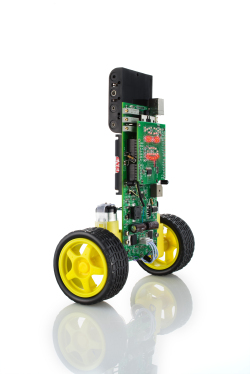 Picture: Chris Hakim
Picture: Chris Hakim
Lil’bot, the little robot that could
Lil’bot is a low-cost, open-source, Arduino-compatible balancing robot created by Chris Hakim. It is ideal for learning to program, hacking and, of course, entertainment.
Although not related to Arduino, Lil’Bot is completely Arduino compatible. Lil’bot comes with complete documentation which includes schematics, PCB-layout database, parts lists and ordering information, assembly instructions, etc.

Lil’bot Features
Odomotry : data from motion sensors is used to estimate change in postion. In this case the motion from the two wheels is used to determine the change in postion
Software: Lil’Blocks
To introduce children to programming, a block-based programming language is used based on Fred Lin’s BlocklyDuino, a dialect of Neil Fraser's Blockly for Arduino. In this programming language, called “Lil’Blocks”, the Blockly code language is visualized by Lego-like block images and then translated into Arduino C.

Using this Lil’Blocks makes programming little more than assembling Lego bricks, yet allows a ?rm grasp of basic programming concepts.
Please note that while younger children can easily learn block programming, some aspects of Lil’Bot require patient adult assistance to bring out all it has to offer.
EmoShield
Your Lil’bot robot can express some artificial emotions through an emoticon-like LED display called “EmoShield”. Artificial emotions that can be displayed are: fear, amusement, anger, blissfulness, being cool, crying, disappointment, embarrassment, happiness, impatientness, being naughty, neutral, nonplussed, outraged, pride, resigned, sad, sarcastic, shocked, smiling, and very sad. Give your robot the gift of emotional expression.
The Arduino-compatible emoShield allows your robot to tell you how it feels!

Power
The robot uses 7 AA alkaline batteries. In the future possibly 8, but this is not finalized yet. Alternatively you could use NiMH rechargeable batteries or Open Fuel Cell’s new Arduino shield.